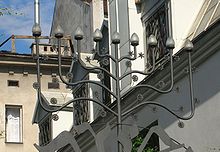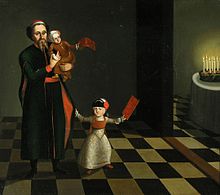Hanukkah
![]()
Hanuka is a redirect to this article. For the Israeli illustrator and comic artist, see Asaf Hanuka.
Hanukkah (Hebrew חֲנֻכָּה / חנוכה 'consecration, dedication' [xanʊˈkaː]![]() ; spellings: Hanukkah, Hanukkah) or Festival of Lights is an eight-day Jewish festival celebrated annually to commemorate the rededication of the Second Temple in Jerusalem in 164 BC or the year 3597 of the Jewish calendar. It begins on the 25th day of the month of Kislev (November/December).
; spellings: Hanukkah, Hanukkah) or Festival of Lights is an eight-day Jewish festival celebrated annually to commemorate the rededication of the Second Temple in Jerusalem in 164 BC or the year 3597 of the Jewish calendar. It begins on the 25th day of the month of Kislev (November/December).

Hanukkia in Kazimierz (Krakow)
History
Hanukkah commemorates the rededication of the second Jewish temple in Jerusalem in the Jewish year 3597 (164 BCE) after the successful Maccabean revolt of the Jews of Judea against Hellenized Jews and Seleucids, as recorded in the First Book of Maccabees, Flavius Josephus, and the Talmud. The Maccabees ended the Seleucid Empire's rule over Judea and reinstated the traditional Jewish temple service. They removed the altar to Zeus previously erected in the Jewish temple by Hellenized Jews who had equated YHWH with Zeus and worshipped in the Greek manner.
The menorah, the seven-branched candelabrum in the temple, was never to go out. According to later tradition, because of the battles with the Seleucids, there was only one jar of consecrated oil left. This oil was only enough for one day. It took eight days to produce new consecrated oil. By a miracle, however, the light had burned for eight days until new consecrated oil had been produced. This is commemorated by the eight lights of the 8- or 9-branched candelabrum, Hanukkia. Every day, one more light is lit until all eight are burning at the end.
The candlestick often has nine arms or light holders, the ninth light being the servant (Hebrew שׁמשׁ Shamash). Only with this may the others be lit, after the necessary blessings (Hebrew ברכה Brachot) have been said. Candles or oil lamps are used as lights. Olive oil is often used, as in the menorah in the former Temple.
After the desecration of the Second Temple by the cult of Zeus, the Hanukkah miracle was celebrated to commemorate its rededication (1 Macc 4:36-59 EU; 2 Macc 10:5-8 EU (Septuagint)) (a time in the New Testament (John 10:22 EU) dates after the feast of the dedication of the Temple) until the year 3830 Jewish calendar (70 CE) when the Temple was finally destroyed by the Romans. Hanukkah is celebrated in families and communities.

Hanukkah celebration in an 18th century painting by an unknown painter in a private collection

Hanukkah candlestick from Frankfurt am Main 1681

Hanukkia (Göttingen, City Museum)
In the Talmud
Hanukkah is treated only briefly in the Babylonian Talmud. The relevant passage is Tractate Shabbat, 21b. In the thematic context of the commandments concerning the lighting of the candle on Shabbat, the lighting of the candle of Hanukkah is also discussed, and from there also the origin of the festival.
"The rabbis taught: The commandment of Hanukkah is one (single) candle for everyone and his family. And for the zealous: One candle for each individual (in the family). And for the especially zealous: The School of Shammai says: "On the first day light eight candles and from then on (every day) light one (candle) less." And the school of Hillel says, "On the first day light one (candle) and from then on (every day) light one candle more." ... The rabbis taught, "It is a commandment to place the candle of Hanukkah in the entrance of the house on the outside. One who lives on the upper floor places it in the window that faces the street. And in the hour of danger, one places it on his table and (that is) enough."
- Babylonian Talmud, Tractate Shabbat, chapter 2, page 21b
The lighting of a candle is therefore the center of the feast. The widespread way of lighting candles today corresponds to the described commandment for the particularly zealous in the version of Hillel's school, according to which one more candle is lit every day. The candles are to be placed in public spaces. This commandment may be deviated from in times of persecution.
This is followed by a question about the origin of the festival.
"What is Hanukkah? The rabbis taught: On the 25th (of the month) of Kislev (begin) the eight days of Hanukkah. On them there must be neither mourning nor fasting. When the Greeks invaded the Temple, they defiled all the oils that were in the Temple. After the kingship of the house of the Hasmoneans was strengthened and defeated them [= the Greeks], they [= the Hasmoneans] checked and found nothing except a vessel of oil which was (still) sealed with the seal of the high priest. In it was oil for no more than to light (the lampstand) for one day. A miracle took place and it was lit with it for eight days (the lampstand). The following year they appointed those (days) and made them feast days of praise and thanksgiving."
- Babylonian Talmud, Tractate Shabbat, chapter 2, page 21b
Questions and Answers
Q: What is Hanukkah?
A: Hanukkah is a Jewish holiday which celebrates the victory of the Maccabees over the larger Syrian army, as well as a miracle that happened during this time. It lasts for eight days and begins on the 25th day of Kislev according to the Hebrew calendar. The Hebrew word hanukkah means rededication.
Q: What is an important symbol associated with Hanukkah?
A: The hanukiah (or hanukkah menorah) is an important symbol associated with Hanukkah. It is a candle holder with nine branches, and one candle separated from the rest, usually by being higher than the other eight.
Q: How are candles lit during Hanukkah?
A: Candles are never lit directly - instead, the higher candle (called a shamash, meaning "attendant") is lit first, and then used to light the rest of the candles. While they are lit, blessings are said over them.
Q: What game do Jewish children often play during Hanukkah?
A: Jewish children often play a game called dreidel during Hanukkah. The dreidel is a four-sided spinning top, each side having a Hebrew letter which stands for either "Nes gadol haya shaam" or "Nes gadol haya po," depending on where it's played - meaning either "a great miracle happened there" or "a great miracle happened here."
Q: When does Hanukkah occur in relation to other calendars?
A: On the Gregorian calendar, Hanukkkah occurs late November or December - for example in 2013 it started on November 27th.
Q: What do each of these letters mean when playing Dreidel?
A: The four letters (nun, gimel, hey and shin) stand for either "Nes gadol haya shaam" or "Nes gadol haya po," depending on where it's played - meaning either "a great miracle happened there" or "a great miracle happened here."
Search within the encyclopedia